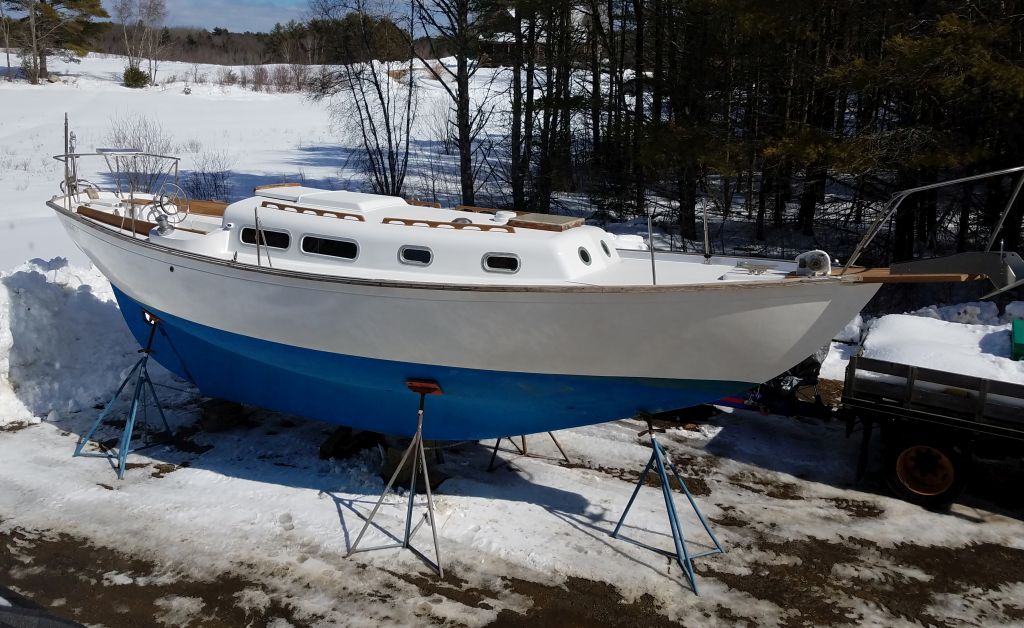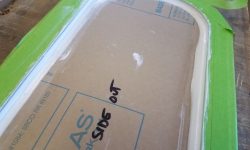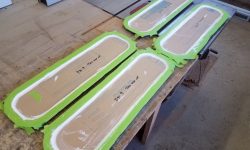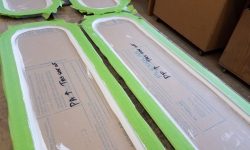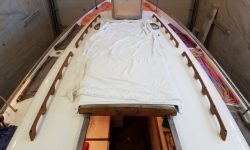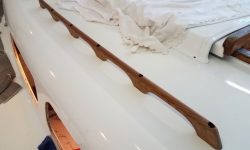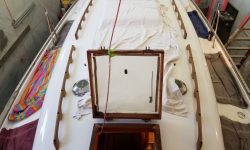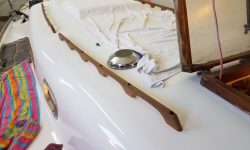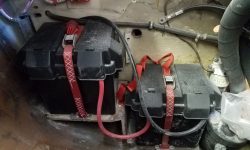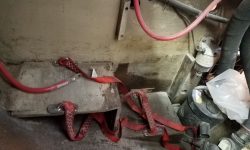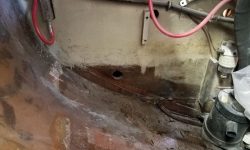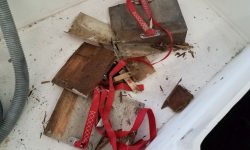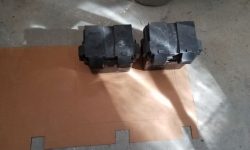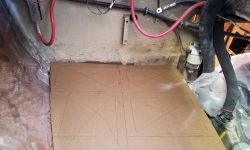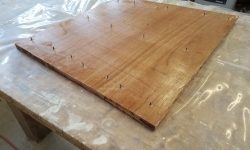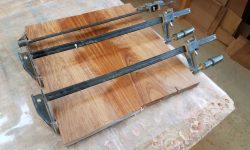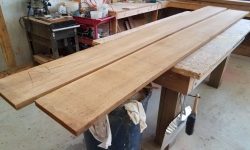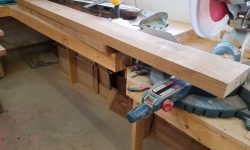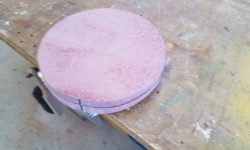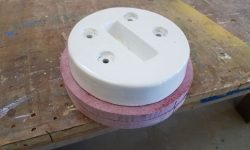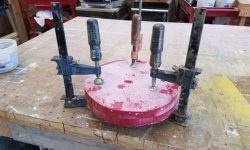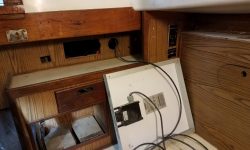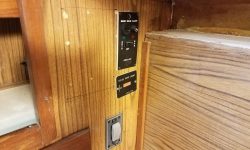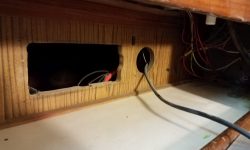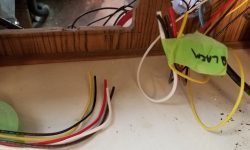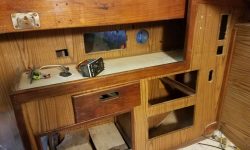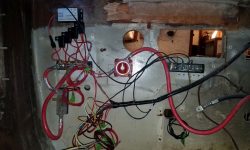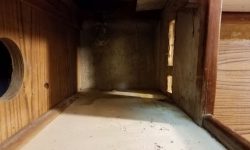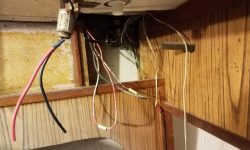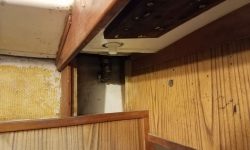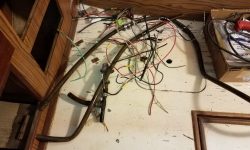February 19, 2018
Jasmine 54
Monday
I got started with the deadlights, and applied a bead of sealant along the outer edge of the new lenses and into the outer groove of the frame, smoothing it out for a pleasing external appearance. The top of the bead was flush with the face of the deadlight frame, and the inner edge tapered away at the edge of the protective paper still on the lens. I left the new beads to cure for a couple days.
On deck, I removed the now-cured excess sealant and tape from around the handrails on the coachroof.
Earlier in the project, I’d removed the existing–and rotten–battery platform from the cockpit locker, as the owner had requested not only replacement, but also enlargement to accommodate another pair of the 6-volt batteries he had. So back then, over a couple separate days while working on other things, I’d removed the batteries and the old platforms, and cleaned up the hull and bulkhead where the old platform had been installed. It had remained in this ready/clean state since then. and now it was time to turn to the new platform construction.
I determined the footprints (base of the battery box) and “airprints” (the overall shadow of the larger top of the box) of the existing battery boxes and used this information, along with the restrictions of the space itself, to create a cardboard template of the new platform, which I planned to make in a single level to hold all four batteries. I trimmed the hull edge to fit as needed.
Template complete, I transferred the shape to some leftover 7mm and 9mm marine plywood that I had and laminated two layers together with epoxy to make up an appropriately thick section for the platform, aiming for at least 18mm (3/4″) thickness. I used two thinner layers since that’s what I had available. I set the glue-up aside for the epoxy to cure.
I was expecting new teak to arrive soon for the coamings and anchor platform, but in the meantime I planed smooth and dimensioned a piece of leftover teak that I could use to make a cover/seat over the steering gear box in the cockpit; the original one had been lost long before. This required changing the planer blades, which were dulled from the last time I used the planer on teak some time before, and while I was set up I took the opportunity to plane some rough cherry for another, unrelated, project in the works.
The piece was overlong but underwide, so I cut it in half to create two shorter pieces that I glued together with epoxy, setting it aside to cure.
The new teak stock for the project arrived in mid-afternoon, and I looked forward soon to getting to work on the new construction.
Earlier, looking at the mast base, I’d determined that we could cut off 1-1/2″ and be past the corrosion problem at the base, and this worked out well since I happened to have a sheet of 3/4″ prefab fiberglass on hand and–wouldn’t you know–two layers of this would perfectly match the amount needed to cut off the base, so I chose to use the material on hand to build up the mast step accordingly. Though I strove to keep the extra height to a minimum, of course I would have goner higher or purchased other material to build it had it been necessary.
From this sheet, I cut out two circles of material just a bit larger in diameter than the original mast step, since I thought a stepped arrangement would look better than keeping the diameter consistent. I laminated the two discs together with epoxy, clamping securely while the adhesive cured. I’d continue work on the blank later on.
Most of the old electrical system had already been removed, either by the owner during last summer, or by me during earlier parts of the project. But there were still a couple little rats’ nests of wiring at the aft end of the main cabin on both sides, and on the port side I needed to remove–and later rearrange–some wiring that we planned to keep and reuse for the bilge pumps, including a switch, counter, and bilge alarm panel. The owner had installed these things temporarily for last season, but now wanted the moved to the panel above the countertop, beneath the deck overhang. In any event, I needed to pull the existing wiring back into the cockpit locker (where the essentials of the electrical system were located) so I could work from scratch to lead the existing and new wiring as needed.
I removed obsolete wiring that led through the space, and noted for future reference the wire positions on the switch, alarm, and counter for ease of reconnection later. I had to cut the wiring leading to both the counter and alarm, since the panels were hardwired and the other ends of these wires led to the bilge itself, so I couldn’t otherwise remove and reposition the units. I led the remaining wires (to be kept and reused) back into the cockpit locker, where I loosely secured them for the moment. The existing main battery and engine wiring would remain more or less as is going forward, as it was new and in good condition, but I’d make some minor changes as needed to reposition things for the new circuit breaker panel and other installations as time went on.
On the other side of the cabin there was a similar mess of old wiring, but nothing needed to be saved, so in short order I had that cleared out as well. I also removed the old hoses from the obsolete little cockpit seat drains, and I’d be replacing that with new 3/4″ hoses to the new fittings in due course.
Total time billed on this job today: 7.75 hours
0600 Weather Observation: 10°, clear. Forecast for the day: Sun, then increasing clouds, mid-40s


